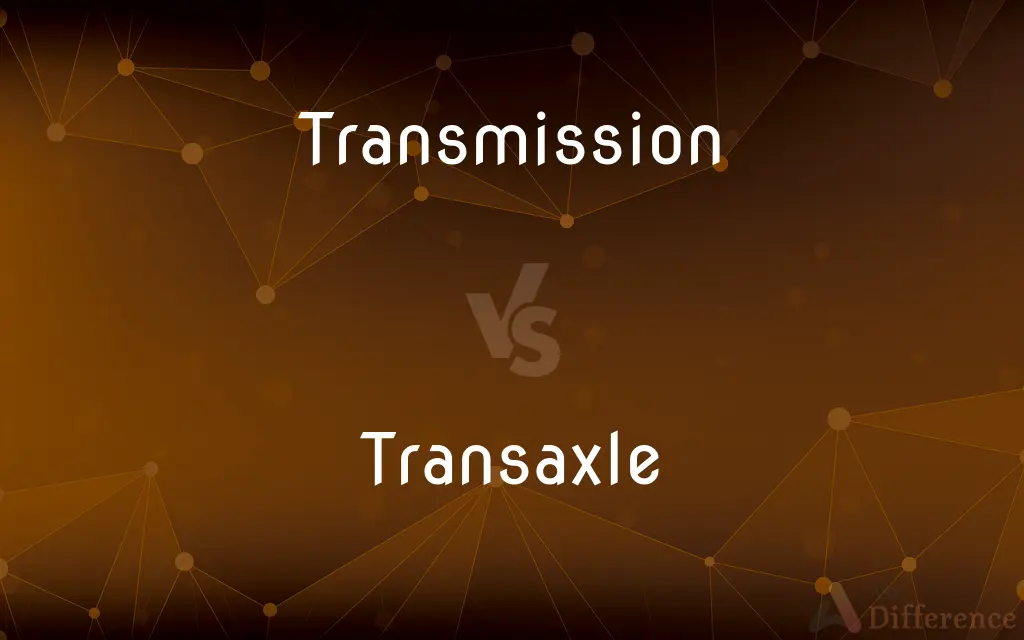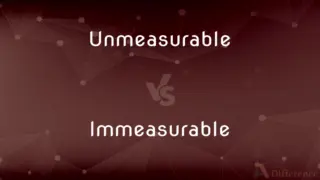Transmission vs. Transaxle — What's the Difference?
By Urooj Arif & Fiza Rafique — Updated on April 1, 2024
Transmission refers to the gearbox in vehicles, facilitating power from the engine to the wheels, while a transaxle combines transmission with axle components in one unit.

Difference Between Transmission and Transaxle
Table of Contents
ADVERTISEMENT
Key Differences
A transmission is a crucial component in vehicles, consisting primarily of a gearbox that manages the distribution of power from the engine to the drivetrain. It plays a pivotal role in controlling the speed and torque of the vehicle, allowing it to move forward or backward. On the other hand, a transaxle is a more specific type of transmission found primarily in front-wheel drive and some rear-engine vehicles. It combines the functions of the transmission, differential, and, in some cases, the drive axle into a single integrated assembly.
Transmissions can be manual or automatic, requiring the driver to manually shift gears or automatically adjusting gears, respectively. This component is essential for changing the vehicle’s gear ratio and adapting to various driving conditions. Whereas, transaxles not only perform these functions but also incorporate the differential, distributing power to the wheels while allowing them to rotate at different speeds—essential for turning maneuvers.
In vehicles with a traditional layout, where the engine is mounted longitudinally at the front, a separate transmission and differential are common. This configuration often uses a driveshaft to connect the transmission at the vehicle's front to the differential at the rear. Conversely, vehicles equipped with a transaxle typically have the engine and transmission mounted transversely (side to side), which saves space and is more efficient for front-wheel drive configurations.
The choice between using a transmission and a transaxle depends on the vehicle’s design and drivetrain layout. Rear-wheel drive vehicles traditionally rely on a separate transmission and differential, emphasizing power and durability. In contrast, front-wheel drive vehicles, which prioritize space-saving and efficiency, typically utilize a transaxle to combine these components into a single compact unit.
Understanding the difference between a transmission and a transaxle is vital for automotive enthusiasts and professionals. It not only aids in vehicle maintenance and repair but also enriches one's knowledge of automotive design and functionality, highlighting the engineering choices that influence vehicle performance and handling.
ADVERTISEMENT
Comparison Chart
Definition
A gearbox that manages power from the engine to the drivetrain.
Combines transmission, differential, and drive axle into one unit.
Primary Function
Controls the vehicle’s speed and torque.
Distributes power to the wheels and allows for differential wheel rotation.
Type of Vehicles
Used in both front and rear-wheel drive vehicles.
Primarily found in front-wheel drive and some rear-engine vehicles.
Components Included
Gearbox only.
Gearbox, differential, and sometimes the drive axle.
Configuration
Separate from the differential.
Integrates the transmission with the differential.
Compare with Definitions
Transmission
Facilitates power transfer from engine to wheels.
Modern cars feature automatic transmissions for smoother gear shifts.
Transaxle
Combines gearbox and differential in one unit.
Front-wheel drive vehicles commonly use transaxles for efficiency.
Transmission
Can be manual or automatic.
Manual transmissions require the driver to manually select gears.
Transaxle
Efficient for certain vehicle layouts.
Transaxles are preferred in vehicles where space saving is crucial.
Transmission
Essential for changing gear ratio.
The transmission adjusts the gear ratio depending on the vehicle’s speed.
Transaxle
Found in front-wheel drive configurations.
Transaxles are a hallmark of compact and efficient vehicle designs.
Transmission
Used in various drivetrain layouts.
Both front-wheel and rear-wheel drive vehicles use transmissions.
Transaxle
Saves space by integrating components.
The transaxle design allows for more passenger or cargo space.
Transmission
Focuses on speed and torque control.
Transmissions ensure optimal engine performance across different speeds.
Transaxle
Allows wheels to rotate at different speeds.
The differential part of a transaxle facilitates smooth turns.
Transmission
The action or process of transmitting something or the state of being transmitted
The transmission of the virus
Transaxle
A transaxle is a single mechanical device which combines the functions of an automobile's transmission, axle, and differential into one integrated assembly. It can be produced in both manual and automatic versions.
Transmission
The mechanism by which power is transmitted from an engine to the axle in a motor vehicle
A three-speed automatic transmission
Transaxle
An automotive part that combines the transmission and the differential and is used especially on vehicles with front-wheel drive.
Transmission
The act or process of transmitting.
Transaxle
(automobiles) A single unit combining transmission gearbox, clutch, final drive, and differential are combined into a single unit connected directly to the driveshaft, used mostly in rear-engine cars.
Transmission
The fact of being transmitted.
Transmission
Something, such as a message, that is transmitted.
Transmission
An assembly, as in a motor vehicle, that transmits power from an engine to a driving axle, usually having a manually or automatically adjustable mechanism to control the balance of power and speed. Also called gearbox.
Transmission
The sending of a signal, picture, or other information from a transmitter.
Transmission
The act of transmitting, e.g. data or electric power.
Transmission
The fact of being transmitted.
Transmission
Something that is transmitted, such as a message, picture, or a disease; the sending of such a thing.
Transmission
(biology) The passage of a nerve impulse across synapses.
Transmission
(automotive) An assembly of gears through which power is transmitted from the engine to the driveshaft in a motor car / automobile; a gearbox.
Transmission
(legal) The right possessed by an heir or legatee of transmitting to his successor(s) any inheritance, legacy, right, or privilege, to which he is entitled, even if he should die without enjoying or exercising it.
Transmission
(medicine, biology) The passing of a communicable disease from an infected host individual or group to a conspecific individual or group.
Transmission
The act of transmitting, or the state of being transmitted; as, the transmission of letters, writings, papers, news, and the like, from one country to another; the transmission of rights, titles, or privileges, from father to son, or from one generation to another.
Transmission
The right possessed by an heir or legatee of transmitting to his successor or successors any inheritance, legacy, right, or privilege, to which he is entitled, even if he should die without enjoying or exercising it.
Transmission
The mechanism within a vehicle which transmits rotational power from the engine to the axle of the wheel propelling the vehicle; it includes the gears and gear-changing mechanism as well as the propeller shaft.
Transmission
The process or event of sending signals by means of a radio-frequency wave from an electronic transmitter to a receiving device.
Transmission
The act of sending a message; causing a message to be transmitted
Transmission
Communication by means of transmitted signals
Transmission
The fraction of radiant energy that passes through a substance
Transmission
An incident in which an infectious disease is transmitted
Transmission
The gears that transmit power from an automobile engine via the driveshaft to the live axle
Common Curiosities
Why do front-wheel drive vehicles prefer transaxles?
For space efficiency and to integrate essential components into a single unit.
Can all vehicles use a transaxle?
Not all; transaxles are typically used in front-wheel drive and certain rear-engine layouts.
What's the main difference between a transmission and a transaxle?
The transmission is a standalone gearbox, while a transaxle combines the gearbox with the differential and possibly the axle.
Is a transaxle better than a transmission?
"Better" depends on the vehicle's design and performance requirements; each has its advantages.
Can a vehicle have both a transmission and a transaxle?
No, they are alternative designs; a vehicle will use one or the other.
What types of transmissions are there?
Manual, automatic, continuously variable (CVT), and dual-clutch (DCT) are common types.
Are transaxles more expensive to repair than transmissions?
Repair costs can vary, but transaxles might be pricier due to their complexity.
How does the differential function in a transaxle?
It allows the wheels to rotate at different speeds, essential for turning.
How does a transaxle improve vehicle design?
It saves space and can improve the vehicle's balance by distributing weight more evenly.
Can you retrofit a transaxle into a vehicle designed for a separate transmission and differential?
Such modifications are complex and typically not practical due to design constraints.
Why might a rear-wheel drive vehicle not use a transaxle?
Traditional RWD layouts benefit from the separation of transmission and differential for performance and repairability.
How do manual transmissions differ from automatic in terms of driver control?
Manual transmissions require the driver to manually select gears, offering more control but requiring more skill.
How do transaxles affect vehicle handling?
They can improve handling by optimizing weight distribution and space utilization.
What advancements have been made in transmission technology?
Innovations include more gears in automatic transmissions and improved efficiency in CVTs and DCTs.
What environmental benefits do efficient transmissions and transaxles offer?
They can improve fuel efficiency and reduce emissions by optimizing power transfer and vehicle weight distribution.
Share Your Discovery

Previous Comparison
Established vs. Incorporated
Next Comparison
Unmeasurable vs. ImmeasurableAuthor Spotlight
Written by
Urooj ArifUrooj is a skilled content writer at Ask Difference, known for her exceptional ability to simplify complex topics into engaging and informative content. With a passion for research and a flair for clear, concise writing, she consistently delivers articles that resonate with our diverse audience.
Co-written by
Fiza RafiqueFiza Rafique is a skilled content writer at AskDifference.com, where she meticulously refines and enhances written pieces. Drawing from her vast editorial expertise, Fiza ensures clarity, accuracy, and precision in every article. Passionate about language, she continually seeks to elevate the quality of content for readers worldwide.














































